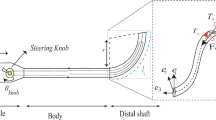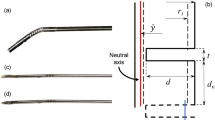Abstract
Minimally invasive steerable catheters, commonly implemented in cardiac ablation, are currently operated by interventionalists exposing them to X-ray radiation and requiring the dexterity for accurate steering. To conduct robot-assisted cardiac ablation, highly accurate stable control platform for precise force/position control on the moving tissue is required. This paper introduces hybrid force/position control strategy to apply a constant force to the cardiac tissue while tracking the desired trajectory. The position controller is based on a nonlinear model predictive tracking control satisfying the input constraints. Cosserat rod theory is incorporated for the distal shaft modeling of tendon-driven catheters, and the model is reformulated for controller design and stability proof. Lyapunov-based stability analysis is conducted. To apply the controller, the force-displacement mapping of the cardiac tissue is obtained through ex vivo experimental tests. The performance of the controller is evaluated, and the catheter is capable of regulating the force with the RMSE of 4.9 mN and tracking the position with the RMSE of 0.89 mm. The promising results verify the potential of the application of the introduced approach in real applications including in vitro and clinical cardiac ablation.
Similar content being viewed by others
References
B. L. Nguyen, J. L. Merino, and E. S. Gang, “Remote navigation for ablation procedures-A new step forward in the treatment of cardiac arrhythmias,” European Cardiology, vol. 6, no. 3, pp. 50–56, 2010. [click]
W. Saliba, V. Y. Reddy, O. Wazni, J. E. Cummings, J. D. Burkhardt, M. Haissaguerre et al., “Atrial fibrillation ablation using a robotic catheter remote control system: initial human experience and long-term follow-up results,” Journal of the American College of Cardiology, vol. 51, no. 25, pp. 2407–2411, 2008. [click]
Y. Fu, H. Liu, W. Huang, S. Wang, and Z. Liang, “Steerable catheters in minimally invasive vascular surgery” The International Journal of Medical Robotics and Computer Assisted Surgery, vol. 5, no. 4, pp. 381–391, 2009. [click]
M. P. Armacost, J. Adair, T. Munger, R. R. Viswanathan, F. M. Creighton, and D. Curd et al., “Accurate and reproducible target navigation with the stereotaxis niobe ® magnetic navigation system,” Journal of Cardiovascular Electrophysiology, vol. 18, no. s1, pp. S26–S31, 2007. [click]
E. M. Khan, W. Frumkin, G. A. Ng, S. Neelagaru, F. M. Abi-Samra, M. Freddy et al., “First experience with a novel robotic remote catheter system: Amigo™ mapping trial,” Journal of Interventional Cardiac Electrophysiology, vol. 37, no. 2, pp. 121–129, 2013. [click]
D. B. Camarillo, C. F. Milne, C. R. Carlson, M. R. Zinn, and J. K. Salisbury, “Mechanics modeling of tendon-driven continuum manipulators,” IEEE Trans. on Robotics, vol. 24, no. 6, pp. 1262–1273, 2008.
M. Khoshnam, M. Azizian, and R. V. Patel, “Modeling of a steerable catheter based on beam theory,” Proc. of IEEE International Conference on Robotics and Automation (ICRA), pp. 4681–4686, 2012.
R. J. Webster, and B. A. Jones, “Design and kinematic modeling of constant curvature continuum robots: A review,” The International Journal of Robotics Research, vol. 29, pp. 1661–1683, 2010. [click]
T. Mahl, A. E. Mayer, A. Hildebrandt, and O. Sawodny, “A variable curvature modeling approach for kinematic control of continuum manipulators,” Proc. of American Control Conference (ACC), pp. 4945–4950, 2013.
B. A. Jones, R. L. Gray, and K. Turlapati, “Three dimensional statics for continuum robotics,” Proc. of IEEE/RSJ International Conference on Intelligent Robots and Systems (IROS), pp. 2659–2664, 2009.
D. Trivedi, A. Lotfi, and C. D. Rahn, “Geometrically exact models for soft robotic manipulators,” IEEE Trans. on Robotics, vol. 24, no. 4, pp. 773–780, 2008.
V. Falkenhahn, T. Mahl, A. Hildebrandt, R. Neumann, and O. Sawodny, “Dynamic modeling of constant curvature continuum robots using the Euler-Lagrange formalism,” Proc. of IEEE/RSJ International Conference on Intelligent Robots and Systems (IROS), pp. 2428–2433, 2014.
I. D. Walker, “Continuous backbone continuum robot manipulators,” ISRN Robotics, vol. 2013, 2013.
M. Dehghani, and S. A. A. Moosavian, “Dynamics modeling of a continuum robotic arm with a contact point in planar grasp,” Journal of Robotics, vol. 2014, 2014.
M. Mahvash, and P. E. Dupont, “Stiffness control of a continuum manipulator in contact with a soft environment,” Proc. of IEEE/RSJ International Conference on Intelligent Robots and Systems (IROS), pp. 863–870, 2010.
Y. Ganji, F. Janabi-Sharifi, and A. Cheema, “Robotassisted catheter manipulation for intracardiac navigation,” International Journal of Computer Assisted Radiology and Surgery, vol. 4, no. 4, pp. 307–315, 2009. [click]
M. Khoshnam, A. Yurkewich, and R. V. Patel, “Modelbased force control of a steerable ablation catheter with a custom-designed strain sensor,” Proc. of IEEE International Conference on Robotics and Automation (ICRA), pp. 4479–4484, 2013.
S. B. Kesner and R. D. Howe, “Robotic catheter cardiac ablation combining ultrasound guidance and force control,” International Journal of The International Journal of Robotics Research, vol. 33, no. 4, pp. 631–644, 2014. [click]
S. B. Kesner, and R. D. Howe, “Motion compensated catheter ablation of the beating heart using image guidance and force control,” Experimental Robotics, pp. 579–590, 2013. [click]
S. S. Antman, Nonlinear Problems of Elasticity, Springer, New York, 1995.
D. Q. Cao, and R.W. Tucker, “Nonlinear dynamics of elastic rods using the Cosserat theory: modelling and simulation,” International Journal of Solids and Structures, vol. 45, no. 2, pp. 460–477, 2008. [click]
Y. Ganji, and F. Janabi-Sharifi, “Catheter kinematics for intracardiac navigation,” IEEE Trans. on Biomedical Engineering, vol. 56, no. 3, pp. 621–632, 2009.
A. Salimi, J. Mohammadpour, K. Grigoriadis, and N. V. Tsekos, “Dynamic simulation of blood flow effects on flexible manipulators during intra-cardiac procedures on the beating heart,” Proc. of American Society of Mechanical Engineers (ASME) Dynamic Systems and Control Conference, pp. 487–494, 2011.
S. S. Keerthi, and E. G. Gilbert, “Optimal infinite-horizon feedback laws for a general class of constrained discretetime systems: Stability and moving-horizon approximations,” Journal of optimization theory and applications, vol. 57, no. 2, pp. 265–293, 1988. [click]
H. K. Khalil, Nonlinear Systems, Prentice hall, New Jersey, 2002.
T. Dierks, and S. Jagannathan, “Optimal control of affine nonlinear continuous-time systems,” Proc. of American Control Conference (ACC), pp. 1568–1573, 2010.
H. Zhang, Q. Wei, and Y. Luo, “A novel infinite-time optimal tracking control scheme for a class of discrete-time nonlinear systems via the greedy HDP iteration algorithm,” IEEE Transactions on Systems, Man, and Cybernetics, Part B (Cybernetics), vol. 38, no. 4, pp. 937–942, 2008.
M. H. Beers, A. J. Fletcher, T. V. Jones, R. Porter, M. Berkwitz, and J. L. Kaplan, The Merck manual of medical information, Merck Research Laboratories, 2003.
S. B. Kesner, and R. D. Howe, “Force control of flexible catheter robots for beating heart surgery,” Proc. of IEEE International Conference on Robotics and Automation (ICRA), pp. 1589–1594, 2011.
F. Perna, E. K. Heist, S. B. Danik, C. D. Barrett, J. N. Ruskin, and M. Mansour, “Assessment of catheter tip contact force resulting in cardiac perforation in swine atria using force sensing technology,” Circulation: Arrhythmia and Electrophysiology, vol. 4, no. 2, pp. 218–224, 2011. [click]
Y. Chen, T. T. Zion, W. Wang, R. Y. Kwong, W. G. Stevenson, and E. J. Schmidt, “Intra-cardiac MR imaging & MRtracking catheter for improved MR-guided EP,” Journal of Cardiovascular Magnetic Resonance, vol. 17, p. 237, 2015. [click]
K. Kwok, K. Lee, Y. Chen, W. Wang, Y. Hu, G. Chow et al., “Interfacing Fast Multi-phase Cardiac Image Registration with MRI-based Catheter Tracking for MRI-guided Electrophysiological Ablative Procedures,” Circulation, vol. 130, pp. A18568–A18568, 2014.
S. G. Yuen, P. M. Novotny, and R. D. Howe, “Quasiperiodic predictive filtering for robot-assisted beating heart surgery,” Proc. of IEEE International Conference on Robotics and Automation (ICRA), pp. 3875–3880, 2008.
Y. Wang, and S. Boyd, “Fast model predictive control using online optimization,” IEEE Trans. on Control Systems Technology, vol. 18, no. 2, pp. 267–278, 2010.
S. G. Yuen, D. P. Perrin, N. V. Vasilyev, J. Pedro, and R. D. Howe, “Force tracking with feed-forward motion estimation for beating heart surgery,” IEEE Trans. on Robotics, vol. 26, no. 5, pp. 888–896, 2010.
A. Z. Faranesh, P. Kellman, K. Ratnayaka, and R. J. Lederman, “Integration of cardiac and respiratory motion into MRI roadmaps fused with x-ray,” Medical Physicsl, vol. 40, no. 3, p. 032302, 2013. [click]
Author information
Authors and Affiliations
Corresponding author
Additional information
Recommended by Guest Editor Sungwan Kim.
Minou Kouh Soltani received her Ph.D. degree in Biomechatronics from University of Tabriz, Iran. She received her B.Sc. and M.Sc. degrees in Control Systems Engineering from University of Tabriz, Iran. She was research fellow at Ryerson University, Toronto, Canada. Her research interests include control theory and its applications to robot-assisted surgeries.
Sohrab Khanmohammadi is a Professor of Control Engineering in Faculty of Electrical and Computer Engineering, University of Tabriz, Iran. He received his B.Sc. in Industrial Engineering from Sharif University of Technology in 1981, Iran, M.Sc. in Automatic from Paul Sabatier University, and Ph.D. in Advanced Automatic and System from National Institute of Aeronautics and Space in France. His research interests include Fuzzy systems, Computer Simulation Techniques, Reliability, Decision making and Project Control.
Farzan Ghalichi is a Professor of Biomedical Engineering at Sahand University of Technology, Tabriz, Iran. He received his Ph.D. and M.Sc. from the Mechanical Engineering Department with collaboration of the Surgery Department of the Laval Univerisity and Quebec Biomaterial Institute, and B.Sc. from the University of Tabriz, Tabriz, Iran. His research interests are Solid and Fluid Mechanics and Biomechanics.
Farrokh Janabi-Sharifi is a Professor of Mechanical-Industrial Engineering and the Director of Robotics, Mechatronics and Manufacturing Automation Laboratory (RMAL) at Ryerson University, Toronto, Canada. He received the Ph.D. degree in Electrical and Computer Engineering from the University of Waterloo, Canada in 1995. He was NSERC postdoctoral fellow and instructor in the Center for Intelligent Machines and Department of Electrical-Computer Engineering of McGill University (1995-1997). His research interests span over optomechatronic systems with the focus on image-guided control and planning of robots. He currently serves as the Associate Editor of several journals including International Journal of Optomechatronics.
Rights and permissions
About this article
Cite this article
Soltani, M.K., Khanmohammadi, S., Ghalichi, F. et al. A soft robotics nonlinear hybrid position/force control for tendon driven catheters. Int. J. Control Autom. Syst. 15, 54–63 (2017). https://doi.org/10.1007/s12555-016-0461-4
Received:
Revised:
Accepted:
Published:
Issue Date:
DOI: https://doi.org/10.1007/s12555-016-0461-4




